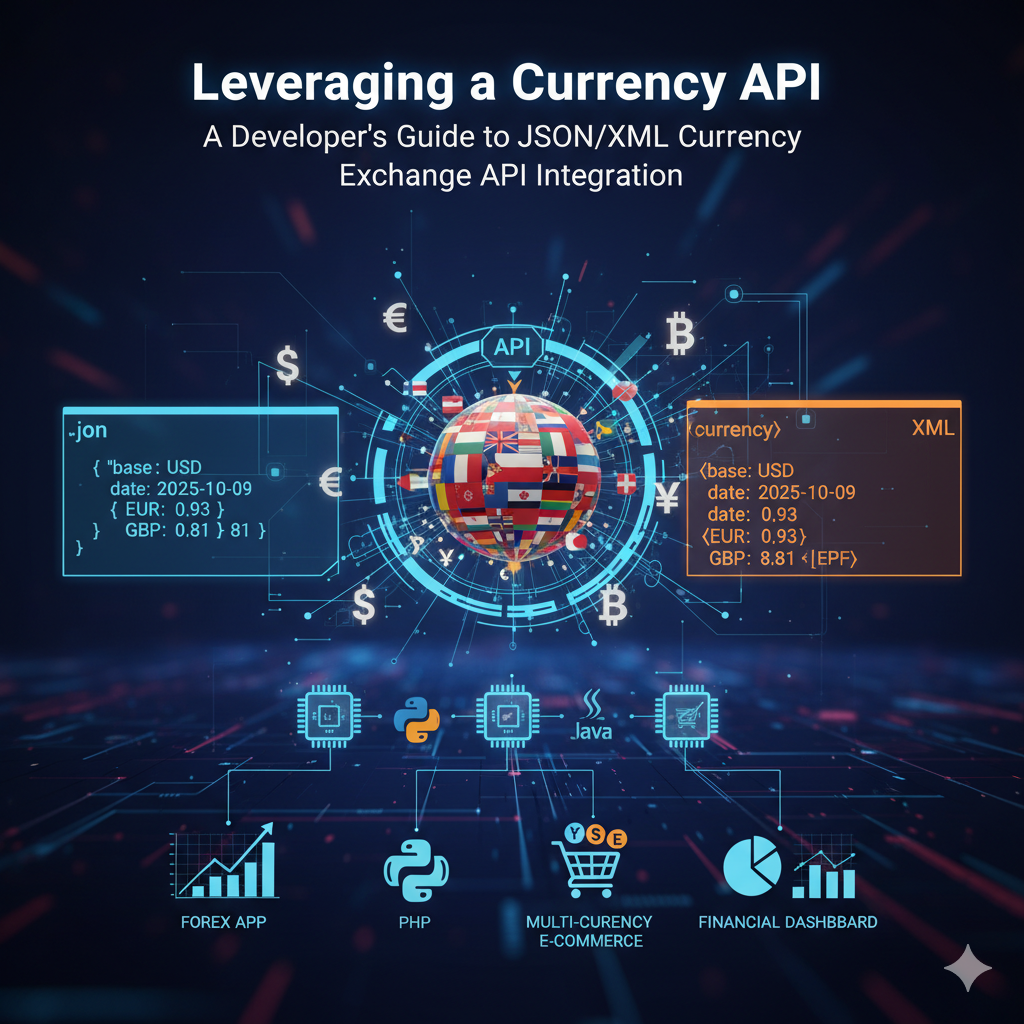Businesses and developers need accurate, real-time currency data to power applications, financial tools, and e-commerce platforms. Whether you’re building a forex app, a multi-currency e-commerce store, or a financial dashboard, a reliable currency API is essential for smooth and accurate operations. This article explores how developers can leverage JSON/XML currency exchange APIs to integrate real-time and historical currency data into their applications.
What is a Currency API?
A currency API is a programming interface that allows developers to retrieve exchange rates between different currencies. These APIs provide data in structured formats such as JSON and XML, making it easy to integrate into web or mobile applications. With a currency API, developers can automate currency conversion, track forex trends, and enable seamless international transactions.
Key Features of a Currency API
- Real-time Exchange Rates: Developers can access live exchange rates, ensuring that users always see the most up-to-date currency values.
- Historical Data: Historical exchange rates allow for trend analysis, financial forecasting, and historical reporting.
- Multiple Formats: JSON and XML formats ensure compatibility with various platforms, programming languages, and frameworks.
- Secure Access: APIs often provide authentication mechanisms, such as API keys, to prevent unauthorized access.
Why Developers Need a JSON/XML Currency Exchange API
Integration of a JSON/XML currency exchange API offers several advantages:
- Ease of Integration: JSON and XML are widely supported data formats, making it easy to fetch and parse currency data using popular programming languages such as JavaScript, Python, PHP, or Java.
- Automation: Automate the retrieval and updating of exchange rates in your application without manual intervention.
- Consistency: Standardized API responses ensure consistent formatting and reduce errors in financial calculations.
- Scalability: APIs can handle high volumes of requests, supporting applications with thousands of users simultaneously.
- Choosing the Right Currency API
- Selecting a reliable currency API is critical for developers. Consider the following factors:
- Accuracy: The API should provide accurate exchange rates from trusted sources.
- Frequency of Updates: Real-time or frequent updates are crucial for applications that require precise currency conversion.
- Documentation: Comprehensive API documentation helps developers implement the API quickly and efficiently.
- Format Support: Ensure the API supports JSON and XML responses to match your application’s requirements.
- Pricing and Limits: Evaluate the API’s pricing structure, request limits, and available free tiers.
JSON vs. XML: Understanding Data Formats
- When working with a currency API, developers often encounter JSON and XML data formats. Here’s a quick comparison:
-
Feature
JSON
XML
Readability
Lightweight, easy to read
Verbose, more complex
Parsing Speed
Faster in modern programming
Slower due to extra tags
Compatibility
JavaScript-friendly
Compatible with most languages
Data Structure
Object-based
Hierarchical, tag-based
- Most modern web applications prefer JSON due to its simplicity and seamless integration with JavaScript. However, XML is still widely used in legacy systems or enterprise environments.
Implementing a Currency API in Your Application
Here’s a step-by-step guide to integrating a JSON/XML currency exchange API into your application:
1. Get API Access
Sign up with a reliable currency API provider and obtain your API key. This key authenticates requests to ensure secure data access.
2. Make API Requests
Use standard HTTP methods like GET to fetch currency data. For JSON responses, you might receive data like this:
{
"base": "USD",
"date": "2025-10-09",
"rates": {
"EUR": 0.93,
"GBP": 0.81,
"JPY": 148.50
}
}
For XML, the same data may look like:
USD
2025-10-09
0.93
0.81
148.50
3. Parse the Data
Most programming languages have libraries for parsing JSON or XML:
JavaScript: JSON.parse() for JSON; DOMParser for XML.
- Python: json module for JSON; xml.etree.ElementTree for XML.
- PHP: json_decode() for JSON; simplexml_load_string() for XML.
4. Display or Process Currency Data
- Once parsed, developers can display exchange rates, perform calculations, or trigger workflows. For example:
- Convert user-entered amounts into different currencies.
- Generate financial reports in multiple currencies.
- Analyze historical currency trends.
Best Practices for Using a Currency API
- Cache Data: Reduce the number of API calls by caching responses for a set period.
- Handle Errors: Implement error handling for failed requests, invalid responses, or rate-limit issues.
- Secure API Keys: Store API keys securely and never expose them in client-side code.
- Monitor Usage: Track API request counts to avoid exceeding limits and incurring additional costs.
Test Thoroughly: Test API integration in different scenarios, including real-time updates and historical queries.
Frequently Asked Questions (FAQs)
1. What is the difference between JSON and XML currency API responses?
JSON is lightweight and easier to parse, making it ideal for web apps. XML is more verbose but is compatible with legacy systems and enterprise applications.
2. How often are currency exchange rates updated?
It depends on the API provider. Some offer real-time updates every few seconds, while others update hourly or daily.
3. Can I use a currency API for free?
Many providers offer free tiers with limited requests per month. Paid plans provide higher limits and additional features like historical data and multiple base currencies.
4. Which programming languages can I use with a currency API?
Currency APIs are language-agnostic. JSON/XML responses can be parsed using JavaScript, Python, PHP, Java, C#, and many other languages.
5. Is it safe to expose API keys in my application?
No. API keys should be stored securely on the server side to prevent unauthorized access.
6. Can I access historical exchange rates using a currency API?
Yes, most APIs provide endpoints for historical rates, allowing developers to analyze past trends.
7. How do I handle API rate limits?
Implement caching and limit request frequency. Consider upgrading to a higher-tier plan if you need more requests.
Why Every Developer Should Integrate a Currency API
A currency API is no longer optional for developers building global applications. With the ability to fetch accurate exchange rates in JSON/XML formats, you can create robust financial tools, multi-currency e-commerce platforms, and forex applications with ease. By choosing the right API, implementing best practices, and handling errors effectively, developers can ensure seamless currency conversion experiences for users.
Ready to integrate reliable currency data into your application?
Explore leading currency APIs today and start building your next multi-currency platform with real-time exchange rates and historical insights. Check out our recommended API providers to get started immediately.






